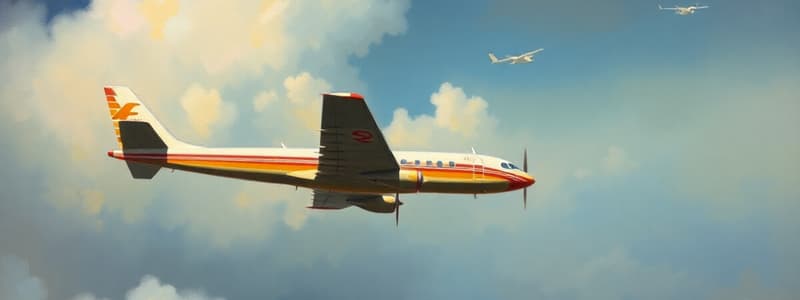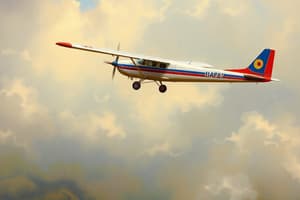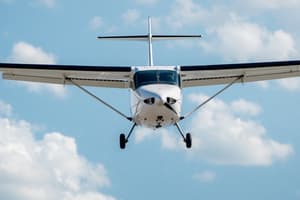Podcast
Questions and Answers
What is the maximum allowable difference between the Captain's or First Officer's altitude display and the field elevation prior to takeoff?
What is the maximum allowable difference between the Captain's or First Officer's altitude display and the field elevation prior to takeoff?
- 100 feet
- 50 feet
- 75 feet (correct)
- 25 feet
An aircraft is operating at 27,000 feet in severe turbulence. Which speed should the flight crew target, considering the regulations for severe turbulent air penetration?
An aircraft is operating at 27,000 feet in severe turbulence. Which speed should the flight crew target, considering the regulations for severe turbulent air penetration?
- 270 knots
- 280 knots
- 0.82 Mach
- The lower of 280 knots or 0.82 Mach (correct)
Under what condition should the flight crew refer to specific tables for takeoff crosswind limits?
Under what condition should the flight crew refer to specific tables for takeoff crosswind limits?
- On contaminated runways with crosswinds exceeding 20 knots.
- On dry or wet runways with crosswinds exceeding 20 knots. (correct)
- On any runway when the crosswind component is greater than 10 knots.
- On dry runways with crosswinds exceeding 15 knots.
What is the operational significance of the MACTOW limits?
What is the operational significance of the MACTOW limits?
What is the maximum allowable cabin pressure differential for takeoff and landing?
What is the maximum allowable cabin pressure differential for takeoff and landing?
Below what minimum altitude AGL after takeoff must the autopilot not be engaged?
Below what minimum altitude AGL after takeoff must the autopilot not be engaged?
When is it permitted to select FLCH mode during takeoff climbout with an engine failed?
When is it permitted to select FLCH mode during takeoff climbout with an engine failed?
What distinguishes a CAT 3B approach from a CAT 3A approach?
What distinguishes a CAT 3B approach from a CAT 3A approach?
Under autoland operations, which combination of wind components represents the operational limits?
Under autoland operations, which combination of wind components represents the operational limits?
What operational guideline applies to the use of FLCH on final approach?
What operational guideline applies to the use of FLCH on final approach?
What is the significance of Maintenance Control being contacted after a rejected takeoff (RTO) in an ER model aircraft?
What is the significance of Maintenance Control being contacted after a rejected takeoff (RTO) in an ER model aircraft?
How many start attempts are permitted within a 60-minute period for the APU's starter motors?
How many start attempts are permitted within a 60-minute period for the APU's starter motors?
What action is required to recall ground handling personnel to the aircraft?
What action is required to recall ground handling personnel to the aircraft?
What is the initial action if no oil pressure indication is observed after the EGT increases during engine start?
What is the initial action if no oil pressure indication is observed after the EGT increases during engine start?
When is an engine start considered complete and stable?
When is an engine start considered complete and stable?
Flashcards
Max Takeoff/Landing Tailwind
Max Takeoff/Landing Tailwind
15 knots
Maximum Operating Altitude
Maximum Operating Altitude
43,100 feet pressure altitude
Max Takeoff/Landing Altitude
Max Takeoff/Landing Altitude
8,400 feet pressure altitude
Manoeuvring Load Limits
Manoeuvring Load Limits
Signup and view all the flashcards
Max Altitude for Flaps Out
Max Altitude for Flaps Out
Signup and view all the flashcards
Severe Turbulence Speed
Severe Turbulence Speed
Signup and view all the flashcards
Max Altimeter Difference (Takeoff)
Max Altimeter Difference (Takeoff)
Signup and view all the flashcards
Landing Crosswind Limits
Landing Crosswind Limits
Signup and view all the flashcards
MACTOW LIMITS
MACTOW LIMITS
Signup and view all the flashcards
Max Differential Pressure
Max Differential Pressure
Signup and view all the flashcards
Max Pressure Differential (Takeoff/Landing)
Max Pressure Differential (Takeoff/Landing)
Signup and view all the flashcards
Min Autopilot Engage Altitude
Min Autopilot Engage Altitude
Signup and view all the flashcards
Autoland Headwind Limit
Autoland Headwind Limit
Signup and view all the flashcards
Glideslope Angle Limits
Glideslope Angle Limits
Signup and view all the flashcards
Maximum Fuel Temperature
Maximum Fuel Temperature
Signup and view all the flashcards
Study Notes
- Maximum takeoff and landing tailwind component is 15 knots.
- Maximum operating altitude is 43,100 feet pressure altitude.
- Maximum takeoff and landing altitude is 8,400 feet pressure altitude.
Flight Maneuvering Load Acceleration Limits:
-
Flaps Up: +2.5g to –1.0g
-
Flaps Down: +2.0g to 0.0g
-
The maximum altitude for flaps out is 20,000ft.
Severe Turbulent Air Penetration Speed:
-
270 knots below 25,000 feet.
-
At or above 25,000 feet: 280 knots or 0.82 Mach, whichever is lower.
-
Prior to takeoff, the maximum allowable difference between the Captain’s or First Officer’s altitude display and field elevation is 75 feet.
Crosswind Limits for Takeoff:
- On DRY or WET (not including slippery when wet) runways, crew must refer to tables when crosswinds exceed 20 knots.
- On CONTAMINATED runways, crew must refer to tables when crosswinds exceed 10 knots.
Crosswind Limits for Landing:
-
On DRY or WET runways: 38 knots
-
On CONTAMINATED runways: 15 knots (crew shall refer to the tables below)
-
MACTOW LIMITS: 7.5% to 44%
Cabin Pressurization:
-
Maximum differential pressure (relief valves): 9.1 psi
-
Maximum allowable cabin pressure differential for takeoff and landing: 0.11 psi
-
The autopilot must not be engaged below a minimum engage altitude of 200 feet AGL after takeoff.
-
Without LAND 2 or LAND 3 annunciated, the autopilot must be disengaged below 200 feet AGL.
-
Do not select FLCH mode during takeoff climbout with an engine failed until flaps are up and speed is VREF30 + 80 or greater.
Approach Categories:
- Cat 1: DH 200ft or more, with or without flight director, LAND 2 or LAND 3, Single, dual or triple channel automatic approach and manual landing
- Cat 2: DH below 200 feet but not less than 100 feet, LAND 2 or LAND 3, Dual or triple channel automatic approach and landing (or manual landing)
- CAT 3A: DH below 100 feet but not less than 50 feet, Dual or triple channel automatic approach and landing LAND 2 or LAND 3
- CAT 3B: DH below 50 feet - no DH, Triple channel automatic approach and landing LAND 3
Automatic Landing Maximum Wind Component Speeds:
-
Headwind: 25 knots
-
Tailwind: 15 knots
-
Crosswind: 25 knots (applicable to actual LVO on a non-contaminated runway)
-
Maximum glideslope angle: 3.25 degrees.
-
Minimum glideslope angle: 2.5 degrees.
-
Do not use FLCH on final approach below 1,000 feet AFE.
-
The maximum fuel temperature is 49°C.
Engine EGT Limits in 300:
- Starting: 700
- Takeoff: 920
- Max continuous: 850
Engine EGT Limits in ER:
-
Starting: 750
-
Below 17,000ft: 1095
-
All alts: 1050
-
In the -300, after a rejected takeoff (RTO) is performed where the thrust reversers were deployed, takeoff is prohibited until maintenance action is complete.
-
In the ER, Commanders shall contact Maintenance Control to determine whether maintenance inspection is required before subsequent takeoff is permitted.
APU Starter Motor Duty Cycle:
- 3 start attempts in a 60-minute period (for both electric starter motor and air turbine starter).
- Fuel density must be between 0.7309 and 0.8507 kg/litre.
Minimum Crew Oxygen Pressure Departing from HKG:
-
-300: 1500 psi
-
-ER: 1000 psi
-
The maximum demonstrated takeoff and landing crosswind is 38 knots, including gusts.
-
During oxygen drop test verify that the crew oxygen pressure does not decrease more than 50 PSIG
-
The ground handling personnel can be recalled to the aircraft by flashing the turnoff or taxi lights twice.
-
If there is no oil pressure indication after the EGT increases, do the ABORTED ENGINE START checklist.
-
Engine Start is complete and engine is stable when the red EGT start limit line is no longer displayed.
-300 Engine Warm-Up Recommendations:
- If engines have been shut down more than 1.5 hours: run the engines for at least 5 minutes.
- If engines have been shut down 1.5 hours or less: run the engines for at least 3 minutes.
- If the cleared departure route requires an alternative roll mode (e.g. HDG/TRK SEL):TOGA should be used as the roll mode for takeoff and initial climb; select the desired roll mode at or above 400ft AAL.
Studying That Suits You
Use AI to generate personalized quizzes and flashcards to suit your learning preferences.



